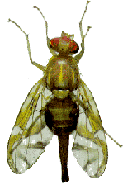Current Invasive Fruit Fly Quarantines in California
Invasive Fruit Flies

Invasive fruit flies are of concern to the agriculture industry in California. The larval (maggot) stage of fruit flies such as Mediterranean fruit fly, Mexican fruit fly and oriental fruit fly can damage most of the fruits and vegetables grown in our state. These and other invasive pests have not become established in California due to (1) strict federal exterior and state interior quarantines, (2) a pest detection program, and (3) aggressive eradication programs when an infestation is discovered.
Federal and state quarantines protect against the entry and spread of invasive fruit flies by requiring strict adherence to treatment and inspection procedures for hosts. Smuggled and/or illegally imported fruit is the most common pathway of fruit fly entry into California.
The California Department of Food and Agriculture (CDFA), in concert with most of the County Agricultural Commissioners, deploy and maintain over 63,000 detection traps statewide just for invasive fruit flies.
The fruit flies (family Tephritidae) of most concern are a group of small (1/5" to 1/3") to medium-sized (3/4") flies, with general body coloration that can be in the red, orange, yellow or black ranges. Their wings generally have brownish streaks and may also display scattered dark spots. There are four life stages: adult; egg; larva; pupa (puparium).
